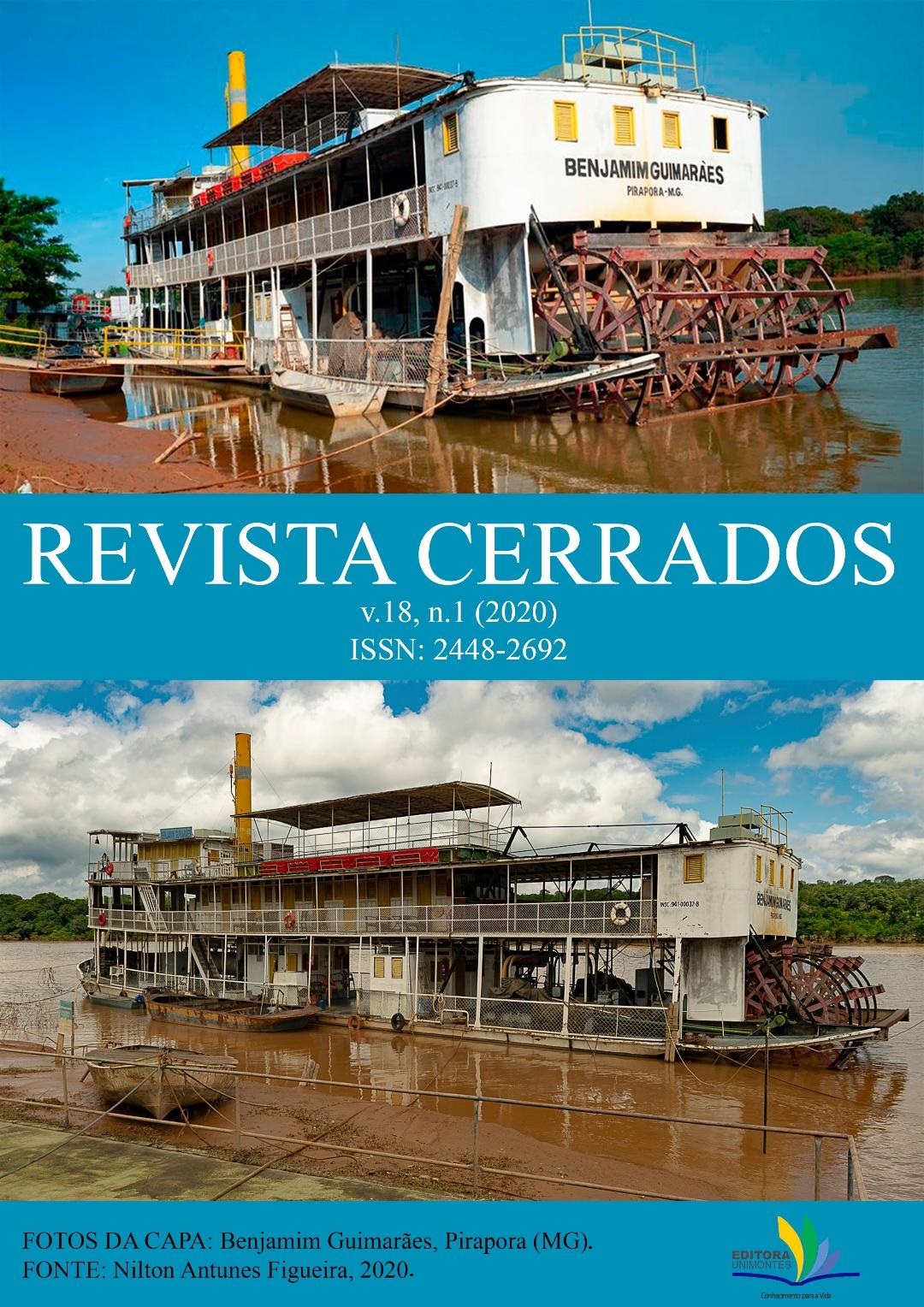The campos rupestres of Espinhaço: mountain range: genetic diversity of endemic species
DOI:
10.46551/rc24482692202003Keywords:
ISSR. Gene Flow. Cerrado. Endemic Specie. Spatial Structure.Abstract
The objective of the study was to characterize the diversity and genetic structure of 82 individuals of P. adamantinum, divided into 02 populations of 41 individuals. We used 08 ISSR primers that amplified 135 loci, with 108 (80%) polymorphic loci between the populations and a mean of 16.9 loci per primer. The mean value of PIC was 0.375. The mean values of the Shannon index (I) and the genetic diversity of Nei (He) were 0.491 and 0.341, respectively. The genetic diversity ratio index (GST = 0.047) showed that the variability between and within the populations contributed with 4.7% and 95.3% of the total heterozygosity (HT), respectively. The observed gene flow was high (Nm = 10,213), which contrasts the effects of genetic drift. The occurrence of low spatial genetic structuration (EGE) (Sp = 0.058) and positive coancestry in both populations (Fij = 0.0161; P < 0.123 in POP01 and Fij = 0.018; P < 0, 057 in POP02), both evaluated up to the second distance class. Even with the presence of factors favorable to inbreeding, P. adamantinum presented high levels of genetic diversity. The high recorded gene flow was responsible for mitigating the effects of mating of related individuals.
Downloads
References
AKURAGUI, C. M.; Biogeografia de Philodendron seção Calostigma (Schott) Pfeiffer (Araceae) no Brasil. Acta Scientiarum, Maringá, v. 23, n. 2, p. 561-569, 2001.
ALBERTTASSE, P. D.; THOMAZ, L. D.; ANDRADE, M. A. Plantas medicinais e seus usos na comunidade da Barra do Jucu, Vila Velha, ES. Revista Brasileira de Plantas Medicinais, [S./l.], v. 12, n. 3, p. 250-260, 2010.
ANDRADE, I. M.; MAYO, S. J.; VAN DEN BERGGO, C.; FAY, M. F.; CHESTER, M.; LEXER, C.; KIRKUP, D. Genetic variation in natural populations of Anthurium sinuatum and A. pentaphyllum var. pentaphyllum (Araceae) from north-east Brazil using AFLP molecular markers. Bot. Jour Linn Soc., [S./l.], v. 159, n. 1, p. 88-105, 2009.
ASADIAR, L. S.; RAHMANI, F.; SIAMI, A. Avaliação da diversidade genética em Oliva Russa (Elaeagnus angustifólia) com base em marcadores genéticos ISSR. Ciência Agronômica, Fortaleza, v. 44, n. 2, p. 310-316, 2012 .
BASHA, S. D.; SUJATHA, M. Inter and intra-population variability of Jatropha curcas (L.) characterized by RAPD and ISSR markers and development of population-specific SCAR markers. Euphytica, [S./l.], v. 156, p. 375-386, 2007.
BOWN, D. Aroids: plants of the Arum family. Portland: Timber Press, 2000.
BRANDÃO, M. M. Diversidade genética de Myrcia splendens (SW.) DC. (Myrtaceae) por marcadores ISSR em sistema corredor-fragmento semideciduais no sul de Minas Gerais. 2008. 80 f. Dissertação (Mestrado em Engenharia Florestal), Universidade Federal de Lavras, Lavras, 2008.
BRANDÃO, M. M.; VIEIRA, F. A.; CARVALHO, D. Estrutura genética em microescala espacial de Myrcia splendens (Myrtaceae). Revista Árvore, [S./l.], v. 35, n. 5, p. 957-964, 2011.
CARDOZO, A. P. Estudos biossistemáticos no complexo Anthurium augustinum K. Koch & Lauche (Araceae). 2013.73 f. Dissertação (Mestrado Botânica), Universidade Federal do Paraná, Curitiba, 2013.
CARVALHO, F. M. V.; MARCO JÚNIOR, P.; FERREIRA, L. G. The Cerrado into pieces: habitat fragmentation as a function of landscape use in the savannas of central Brazil. Biological Conservation, Essex, v. 142, n. 7, p. 1392-1403, 2009.
CAVALLARI, M. M.; FORZZA, R. C.; VEASEY, E. A.; ZUCCHI, M. I.; OLIVEIRA, G. C. X. Genetic variation in three endangered species of Encholirium (Bromeliaceae) from Cadeia do Espinhaço, Brazil, selected using RAPD markers. Biodiversity and Conservation, [s./l.], v. 15, n. 14, p. 4357-4373, 2006.
CLOUTIER, D.; KANASHIRO, M.; CIAMPI, A. Y.; SCHOEN, D. J. Impact of selective logging on inbreeding and gene dispersal in an Amazonian tree population of Carapa guianensisis Aubl. Molecular Ecology, v. 16, 797-809, 2007.
Collevatti R G, Lima J S, Soares T N, Telles M P C Spatial genetic structure and life history traits in Cerrado Tree species: inferences for conservation. Brazilian Journal of Nature Conservation 8(1): 2010, 54-59. Doi: 10.4322/natcon.00801008
CUNHA, N. R. S.; LIMA, J. E.; GOMES, M. F. M.; BRAGA, M. J. A intensidade da exploração agropecuária como indicador da degradação ambiental na região dos Cerrados, Brasil. Piracicaba/SP. RER, São Paulo, v. 46, n. 2, p. 291 -323, 2008.
DA SILVA, B. M.; ROSSI, A. A. B.; DARDENGO, J. F. E.; ARAUJO, V. A. A. C.; ROSSI, F. S.; OLIVEIRA, L. O.; CLARINDO, W. R. Diversidade genética estimada com marcadores entre sequências simples repetidas em cultivos comerciais de Cupuaçuzeiro. Ciência Rural, [S./l.], v. 46, n. 1, p. 108-113, 2016.
DE OLIVEIRA, N. P.; DE OLIVEIRA, M. S. P.; MOURA, E. F. Variabilidade e divergência genética entre genótipos de Tucumanzeiro-do-Pará (Astrocaryum vulgare Mart.) promissores para a produção de frutos por marcadores RAPD. Rev. Bras. Frutic., Jaboticabal, v. 34, v. 1, p. 216-226, 2012.
DÖTTERL, S.; DAVID, A.; BOLAND, W.; SILBERBAUER-GOTTSBERGER , I.; GOTTSBERGER, G. Evidence for Behavioral Attractiveness of Methoxylated Aromatics in a Dynastid Scarab Beetle-Pollinated Araceae. Journal of Chemical Ecology, [S./l.], v. 38, n. 12, p. 1539-1543, 2012.
DOYLE, J. J.; DOYLE, J. L. A rapid DNA isolation procedure for small quantities of fresh leaf tissue. Phytochemical Bulletin, [S./l.], v. 19, p. 11-15, 1987.
DUARTE, J. F. Conservação genética de Ficus bonijesulapensis R.M. Castro em florestas deciduais sobre afloramentos calcários. 2011. 87 f. Dissertação (Mestrado em Ecologia), Universidade Federal de Lavras, Lavras, 2011.
DUARTE, M. M. Diversidade genética de populações naturais de Ziziphus joazeiro Mart. como subsídio para adoção de estratégias de conservação. 2015. 63 f. Dissertação (Mestrado Engenharia Florestal), Universidade Federal do Paraná - UFPR, Curitiba, (2015).
EXCOFFIER, L.; LISCHER, H. E. L. Arlequin suite ver 3.5: a new series of programs to perform population genetics analyses under Linux and Windows. Molecular Ecology Resources, [S./l.], v. 10, p. 564-567, 2010.
FERNANDES, P.A.; PESSÔA, V. L. S. O Cerrado e suas atividades impactantes: uma leitura sobre o garimpo, a mineração e a agricultura mecanizada. Observatorium: Revista Eletrônica de Geografia, Uberlândia, v.3, n.7, p. 19-37, 2011.
FERNANDES, R. C. Diversidade e estrutura genética em populações naturais de pequizeiro (Caryocar brasiliense Camb.) no Norte de Minas Gerais. 2008. 68 f. Dissertação (Mestrado em Engenharia Florestal), Universidade Federal de Lavras, Lavras, 2008.
FERREIRA, M. E.; GRATTAPAGLIA, D. Introdução ao uso de marcadores moleculares em análise genética. 3 ed. Brasília: Embrapa-Cenargen, 1998.
FERREIRA, M. F. M. Análises genéticas de Annona crassiflora (Annonaceae): implicações para a conservação da espécie. 2011. 127 f. Dissertação (Mestrado Ciências Florestais), Universidade Federal de Lavras, Lavras, 2011.
FUTUYAMA, D. J. Biologia evolutiva. Ribeirão Preto: Sociedade Brasileira de Genética, 1992, 631 p.
GE, X. J.; SUN, M. Population genetic structure of Ceriops tagal (Rhizophoraceae) in Thailand and China. Wetlands Ecology and Management, [S./l.], v. 9, p. 203-209, 2001.
GITZENDANNER, M.; SOLTIS, P. S. Patterns of genetic variation in rare and widespread plant congeners. Am. J Bot., [S./l.], v. 87, v. 6, p. 783-792, 2000.
GIUSTINA, L. D.; LUZ, L. N.; VIEIRA, F. S.; ROSSI, F. S.; SOARES-LOPES, C. R. A.; PEREIRA, T. N. S.; ROSSI, A. A. B. Population structure and genetic diversity in natural populations of Theobroma speciosum Willd. Ex Spreng (Malvaceae). Genetics and Molecular Research, [S./l.], v. 13, n. 2, p. 3510-3519, 2014.
GONÇALVES, L. O.; PINHEIRO, J. B.; ZUCCHI, M. I.; SILVA-MANN, R. Caracterização genética de mulungu (Erythrina velutina Willd.) em áreas de baixa ocorrência. Ciência Agronômica, [S./l.], v. 45, n. 2, p. 290-298, 2014.
GÓRSKI, F. Seleção de primers ISSR e estrutura genética populacional de Baccharis crispa Spreng. (Asteraceae) do sul do Brasil. 2015. 58 f. Dissertação (Mestrado Biologia Evolutiva), Universidade Estadual do Centro-Oeste, Guarapuava, 2015.
GOTTSBERGER, G.; SILBERBAUER-GOTTSBERGER, I.; SEYMOUR, R. S.; DÖTTERL, S. Pollination and floral scent differentiation in species of the Philodendron bipinnatifidum (Araceae). Plant Systematics and Evolution, [S./l.], v. 299, p. 793–809, 2013.
HAMRICK, J. L.; GODT, M. J. W. Allozyme diversity in plant species. In: BROWN, A. H. D.; CLEGG, M. T.; KAHLER, A. L.; WEIR, B. S. (ed.). Plant population genetics, breeding and genetic resources. MA/Sunderland: Sinauer Associates, 1989. p.43–63.
HAMRICK, J. L.; GODT, M. J. W. Conservation genetics of endemic plant species. In: AVISE, J. C.; HAMRICK, J. L. (ed.). Conservation genetics: case histories from nature. New York : Chapman & Hall, 1996. p. 281–304.
HARDY, O. J.; VEKEMANS, X. SPAGeDi: a versatile computer program to analyse spatial genetic structure at the individual or population levels. Molecular Ecology Notes, [S./l.], v. 2, n. 4, p. 618-620, 2002.
HERNÁNDEZ, B. G. D. Diversidade genética e desenvolvimento de protocolo de regeneração in vitro em Jatropha curcas. 2015. 65 f. Dissertação (Mestrado Melhoramento Vegetal e Biotecnologia), Instituto Agronômico, Campinas, 2015.
HEYWOOD, V. H. Flowering plants of the world. New York: Oxford University Press, 1993.
HU, Y.; WANG, L.; XIE, X.; YANG, J.; LI, Y.; ZHANG, H. Genetic diversity of wild populations of Rheum tanguticum endemic to China as revealed by ISSR analysis. Biochemical Systematics and Ecology, [S./l.], v. 38, n. 3, p. 264-274, 2010.
KIANI, M.; MEMARIANI, F.; ZARGHAMI, H. Molecular analysis of species of Tulipa L. from Iran based on ISSR markers. Plant Syst Evol, [S./l.], v. 298, p. 1515–1522, 2012.
KUMAR, S.; KUMARIA, S.; SHARMA, S. K.; RAO, S. R.; TANDON, P. Genetic diversity assessment of Jatropha curcas L. germplasm from Northeast India. Biomass and Bioenergy, [S./l.], v. 35, p. 3063-3070, 2011.
LIMA, E. N.; ARAÚJO, M. E. B.; BERTINI, C. H. C. M.; MOURA, C, F, H.; HAWERROTH, M. C. Diversidade genética de clones de aceroleira avaliada por meio de marcadores moleculares ISSR. Comunicata Scientiae, [S./l.], v. 6, n. 2, p. 174-180, 2015.
LORENZONI, R. M.; SOARES, T. C. B.; SANTIAGO, V. F.; SILVA, J. A.; COELHO, R. I. Utilização de marcadores ISSR na avaliação da divergência genética entre acessos de beribazeiro. Ver. Bras. Frutic.,v. 36, n.1, p. 251-257, 2014.
LOVELESS, M. D.; HAMRICK, J. L. Ecological determinants of genetic structure in plant populations. Annual Review of Ecology and Systematics, Palo Alto, v. 15, n. 1, p. 65-95, 1984.
MAYO, S. J. A revision of Philodendron subgenus Meconostigma (Araceae). Kew Bulletin, New York, v. 46, n . 4, p. 601-681, 1991.
McDERMOTT, J. M.; McDONALD, B. A. Gene flow in plant pathosystems. Annual Review of Phytopathology, [S./l.], v. 31, n. 1, p. 353-373, 1993.
MELO JÚNIOR, A. F.; CARVALHO, D.; PÓVOA, J. S. R.; BEAZORTI, E. Estrutura genética de populações naturais de pequizeiro (Caryocar brasiliense Camb.). Scientia Forestalis, Piracicaba, v. 66, n. 1, p. 56-65, 2004.
MELO JÚNIOR, A. F.; CARVALHO, D.; BRANDÃO, M. M.; SOUSA, L. G.; VIEIRA, F. A.; MENEZES, E. V.; ROYO, V. A.; OLIVEIRA, D. A. Spatial genetic structure of Cavanillesia arborea K. Schum. (Malvaceae) in seasonally dry Tropical forest: implications for conservation. Biochemical Systematics and Ecology, [S./l.], v. 58, n. 1, p. 114-119, 2015.
MILLS, L. S.; ALLENDORF, F. W. The one-migrant-pergeneration rule in conservation and management. Conservation Biology, Essex, v.10, n. 6, p.1509-1518, 1996.
MITTERMEIER, R.; GIL, P.; HOFMANN, M.; PILGRIM, J.; & BROOKS, T; MITTERMEIER, C.; LAMOREUX, J.; FONSECA, G. Hotspots Revisited. Earth's Biologically Richest and Most Endangered Terrestrial Ecoregions, 2004.
MONTALDO, A. Cultivo de raíces y tubérculos tropicales. 2 ed. San José, Costa Rica Instituto Interamericano de Cooperación para la Agricultura, 1991, 395 p.
MORAES, M. L. T.; KAGEYAMA, P. Y.; SEBBEN, A. M.; Diversidade e estrutura genética espacial em duas populações de Myracrodruon urundeuva Fr. All. sob diferentes condições antrópicas. Revista Árvore, Viçosa, v. 29, n. 2, p. 281-289, 2005.
MOURA, M. C. O. Distribuição da variabilidade genética em populações naturais de Eremanthus erythropappus (DC.) MacLeish (Asteraceae) por marcadores isoenzimáticos e RAPD. 2005. 125 f. Tese (Doutorado Engenharia Florestal), Universidade Federal de Lavras, Lavras, 2005.
NASCIMENTO, F. W. Diversidade genética de inhame (Dioscorea trifida L.) avaliada por marcadores morfológicos SSR e ISSR. 2013. 89 f. Tese (Doutorado Genética e Melhoramento de Plantas), Escola Superior de Agricultura Luiz de Queiroz, Universidade de São Paulo, São Paulo, 2013.
NASON, J. D.; ALDRICH, P. R.; HAMRICK, J. L. Dispersal and the Dynamics of genetic structure in fragmented tropical tree populations. In: LAURANCE, W. F.; BERREGAARD, R. O. (ed.) Tropical Forest Remmants: Ecology, Management and conservation of fragmented communities. Illinois: University of Chicago Press, 1997, p. 304-320,
NEI, M. Analysis of gene diversity in subdivided populations. Proc. Nat. Acad. Sci, [S./l.], v. 70, n. 1, p. 3321-3323, 1973.
NEI, M. Estimation of average heterozygosity and genetic distance from a small number of individuals. Genetics, Pittsburgh, v. 89, n. 3, p. 583-590, 1978.
NEIGEL, J. E. A comparision of alternative strategies for estimating gene flow from genetic markers. Annual Review Ecology Systematics, Palo Alto, v. 28, n. 1, p. 105-128, 1997.
NETO, J. D. S.; SOARES, T. C. B.; MOTTA, L. B.; CABRAL, P. D. S.; SILVA, J. A. Molecular characterization of Anthurium genotypes by using DNA fingerprinting and SPAR markers. Genet. Mol. Res., [S./l.], v. 13, n. 3, p. 4766-4775, 2014.
NYBOM, H.; BARTISH, I. Effects of life history traits and sampling strategies on genetic diversity estimates obtained with RAPD markers in plants. Perspectives in Plant Ecology, Evolution and Systematics, Amsterdam, v. 3, n. 1, p. 93-114, 2000.
NYBOM, H. Comparison of different nuclear DNA markers for estimating intraspecific genetic diversity in plants. Molecular Ecology, Dordrecht, v. 13, n. 1, p. 1143-1155, 2004.
OLIVEIRA, L. V. L. Avifauna em áreas com diferentes estádios de conservação no Espinhaço Meridional. 2013. 68 f. Dissertação (Mestrado Ciência Florestal), Universidade Federal dos Vales do Jequitinhonha e Mucuri, Diamantina, 2013.
PATEL, H. K.; FOUGAT, R. S.; KUMAR, S.; MISTRY, J. G.; KUMAR, M. Detection of genetic variation in Ocimum species using RAPD and ISSR markers. 3 Biotech, [S./l.], v. 5, n. 1, p. 697-707, 2015.
PEREIRA, J.; SCHLINDWEIN, C.; ANTONINI, Y.; MAIA, A. C. D.; DÖTTERL, S.; MARTINS, C.; NAVARRO, D. M. F. A.; OLIVEIRA, R. Philodendron adamantinum (Araceae) lures its single cyclocephaline scarab pollinator with specific dominant floral scent volatiles. Biological Journal of the Linnean Society, London, v.111, n. 3, p. 679–691, 2014.
PLOWMAN, T. Folk uses of new world aroids. Economic Botany, Oxford, v. 23, n. 2, p. 97-122, 1969.
REED, D. H. Relationship between population size and fitness. Conservation Biology, Oxford, v. 19, n. 1, p. 563–568,2005.
RODRIGUES, J. F. Delimitação de espécies e diversidade genética no complexo Cattleya coccinea Lindl. e C. Mantiqueirae (Flowie) van den Berg (Orchidaceae) baseada em marcadores moleculares ISSR. 2010. 58 f. Dissertação (Mestrado Genética e Melhoramento de Plantas), Escola Superior de Agricultura, USP, Piracicaba, 2010.
ROHLF, F. J. Numerical taxonomy and multivariate analysis system version 2.11. New York: Applied Biostatistics, 2000.
ROSSI, F. S.; ROSSI, A. A. B.; DARDENGO, J. F. E.; BRAUWERS, L. R.; DA SILVA, M. L.; SEBBENN, A. M. Diversidade genética em populações naturais de Mauritia flexuosa L. f. (Arecaceae) com uso de marcadores ISSR. Sci. For., Piracicaba, v. 42, n. 104, p. 631-639, 2014.
SIEBERT, S. F. From shade – to sun-grown perennial crops in Sulawesi, Indonesia: implications for biodiversity conservation and soil fertility. Biodiversity and Conservation, [S./l.], v.11, n. 11, p. 1889-1902, 2002.
SILVA, J. A. P. Interações ecológicas de Philodendron adamantinum (Araceae, Philodendreae) no Parque Estadual do Rio Preto, Minas Gerais: polinização por besouros e interação com formigas. 2013. 65 f. Dissertação (Mestrado Evolução e Funcionamento de Ecossistemas), Universidade Federal de Ouro Preto, Ouro Preto, 2013.
SLATKIN, M. Gene flow and the geographic structure of natural populations. Science, [S./l.], v. 236, n. 1, p. 787-792, 1987.
SMITH, J. F.; PHAM, T. V. Genetic diversity of the narrow endemic Allium aaseae (Alliaceae). American Journal of Botany, [S./l.], v. 83, n. 1, p. 717-726, 1996.
SOUZA, G. A.; CARVALHO, M. R. O.; MARTINS, E. R.; GUEDES, R. N. C.; OLIVEIRA, L. O. Diversidade genética estimada com marcadores ISSR em populações brasileiras de Zabrotes subfasciatus. Pesq. Agropec. Bras., Brasília, v. 43, n.7, p. 843-849, 2008.
UENO, S. Diversidade e estrutura genética de populações de Oeceoclades maculata (Lindl.) Lindl. 2013. 57 f. Dissertação (Mestrado Genética e Melhoramento de Plantas), Escola Superior de Agricultura Luiz de Queiroz, USP, Piracicaba, 2013.
VEKEMANS, X.; HARDY, O. J. New insights from fine-scale spatial genetic structure analyses in plant populations. Molecular Ecology, Oxford, v.13, n. 1, p. 921-935, 2004
VELOSO, H. P.; RANGEL FILHO, A. L. R.; LIMA, J. C. A. Classificação da vegetação Brasileira, adaptada a um sistema universal. Rio de Janeiro: Ministério da Economia, Fazenda e Planejamento, IBGE, 1991.
VIEIRA, F. A. Diversidade e estrutura genética de Protium spruceanum (Benth.) Engler em remanescentes e corredores de vegetação na região do Alto Rio Grande-MG. 2005. 78 f. Dissertação (Mestrado Ciências Florestais), Universidade Federal de Lavras, Lavras, 2005.
VIEIRA, F. A.; SOUSA, R. F.; SILVA, R. A. R.; FAJARDO, C. G.; MOLINA, W. F. Diversidade genética de Copernicia prunifera com uso de marcadores moleculares ISSR. Ver. Bras, Ciênc. Agrár. [S./l.], v. 10, n. 4, p. 525-531, 2015.
WALLACE, L. E. Spatial genetic structure and frequency of interspecific hybridization in Platanthera aquilonis and P. dilatata (Orquidaceae) occurring in simpatry. Am. J. Bot. [S./l.], v. 93, n. 7, p. 1001-1009, 2006.
XING, C.; TIAN, Y.; GUAN, F.; MENG, F. Evaluation of genetic diversity in Amygdalus mira (Koehne) Ricker using SSR and ISSR markers. Plant Syst Evol, [S./l.], v. 301, n. 3, p. 1055-1064, 2015.
YEH, F. C.; YANG, R. C.; BOYLE, T. POPGENE: Microsoft Windows-based freeware for population genetic analysis. Version 1.31. University of Alberta, Canada and Centre for International Forestry Research, Canadá, 1999.
YOUNG, A.; BOYLE, T.; BROWN, T. The population genetic consequences of habitat fragmentation for plants. Trends in Ecology and Evolution, Amsterdam, v. 11, n. 10, p. 413-418, 1996. 1996.
ZIETJIEWICZET, E.; RAFALSKI, A.; LABUDA, D. Genome fingerprinting by simple sequence repeat (SSR)-anchored polymerase chain reaction amplification. Genomics, [S./l.], v. 20, n. 1, p. 176-183, 1994.
Published
How to Cite
Issue
Section
License
Copyright (c) 2020 Revista Cerrados

This work is licensed under a Creative Commons Attribution-NonCommercial-ShareAlike 4.0 International License.
In this journal, the copyrights for published articles belong to the author (s), with the rights of the first publication belonging to Revista Cerrados. The articles are publicly accessible, free to use, their own assignments, educational assignments and non-commercial applications.


















